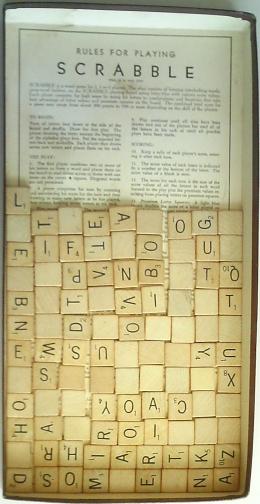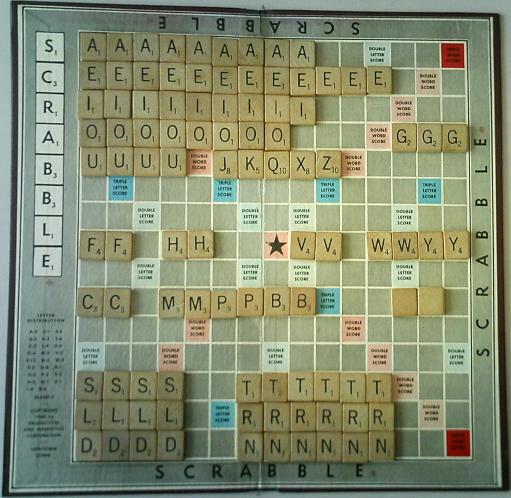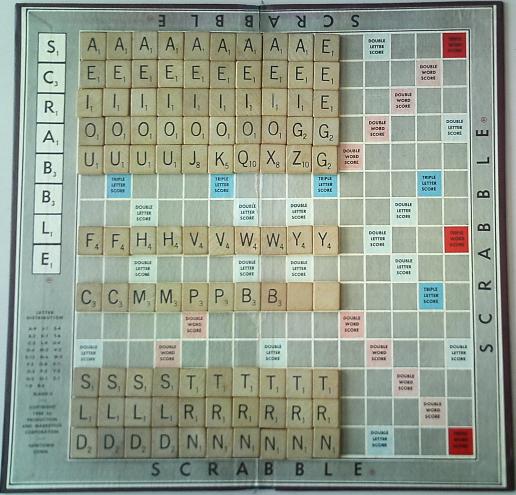
100 Scrabble Tiles - All Shook Down
Back to index of Scrabble pages by Donald Sauter.
Please visit the Scrabble For Word Lovers introduction page.
When I come across an old Scrabble set at a flea market or auction,
I more or less expect some tiles to be missing.
That is probably the least astounding sentence you ever read. Game pieces get lost all the time, right? They are practically meant to get lost. Kids wouldn't be kids if they didn't lose everything they got their dirty, little mitts on. The frightening reality is, if an old game were found complete with all its parts, the fabric of the universe might well be rent.
Still, this raises a profound question: where do lost game pieces disappear to?
For example, if a Scrabble tile falls on the floor, wouldn't you expect somebody to reach down and pick it up? If not right at the moment - maybe it fell silently on a plush carpet - surely at a later time when somebody comes along sweeping or vacuuming, or maybe just looking down. Even if it bounced under the sofa, you'd think it would be found eventually, and somebody would have an "aha" experience: "Well, I vum! A wooden ort! Why, it appears to be a . . . a . . . a Scrabble tile! I shall return it to the Scrabble box forthwith!"
Thus, I have lost almighty sleep wondering which is the greater mystery of the universe: an old game which is complete; or, an old game which is not complete, implying the existence of an unknown, uncharted fifth dimension into which game pieces fall and are never seen again.
But on with the show . . .
There's a nice, round 100 tiles in a Scrabble set. You could simply count them up, but if you only count 99, say, you won't be sure if that's really correct, or if you miscounted. Then you might try again, putting the tiles in piles of 10 which allow you to double-check your count.
Let me suggest a simpler, surer, and more fun method which produces conclusive results. Dump the tiles into the box top or box bottom. Shake them around so that they are mostly all lying on the cardboard, that is, with few or no tiles lying on top of other tiles. Tilt the box so they all slide to one end while shaking gently side to side. Either box part is sized just right so that a horizontal row will contain 9 tiles. After shaking all the tiles into rows, with a bit of digital (that's biological, not computer) help, you will have 11 rows of 9 tiles, with one tile left over. Do the math: 11 x 9 + 1 = 99 + 1 = 100. Bingo (the interjection, not Scrabble play)!

Now, if you are missing tiles, you need to find out what they are.
And even if you have exactly 100, you still have a nagging doubt about
whether you have the correct letter distribution. Well, let's pretend
you have a nagging doubt. I bought an old set once that had
exactly 100 tiles - but with an extra I, and missing an E! (I know,
I know... only a Scrabble nut could put an exclamation mark
at the end of that sentence.)
What we will do is view each Scrabble letter as belonging to a particular "family". Each family has a designated area of the board. With the help of a few mnemonics, you will know instantly what family a tile belongs to, and where it should be placed. When you are done placing the tiles, you can easily see if they are all accounted for - and without having done any error-prone counting.
So open up your Scrabble board, grab a bunch of tiles and start putting them in their place, as follows.
The Vowels (A, E, I, O, U):
The vowels make up the biggest family, and are a cinch to work with. Each vowel takes a row at the top of the board; A on the first row, E on the second, and so on through U on the fifth row.
The 4-pointers (F, H, V, W, Y):
Without actually giving thought to the 4-point value, you recognize members of this family instantly as those wonderful consonants (F, H, W, Y) that everybody scores gobs of cheap points with on double and triple letter score, plus the one black sheep member of the family (V), which everybody hates precisely because you can't score mindless points with it. (Scrabble isn't supposed to require any thinking!)
These all occur in pairs. Place them alphabetically left to right on the middle row (starting with the triple word score). Think: F is the leftmost and Y is the rightmost. Spread out the ones in between so that when a twin shows up, you don't have to reposition a tile you've already placed.
The 3-pointers (C, M, P, B):
Here again, I suggest there's an easier way to recognize this family than by giving conscious thought to the point value. I use the word CaMPBell as my mnemonic, which is why I list them in the order you see. Think of Campbell's soup, or "The Campbells Are Coming". Growing up, I always thought that silent P and the crush of consonants in "Campbell's" was kind of weird, which I'm sure is why that word jumps to mind when I see those letters. I hope it works for you, too.
These also occur in pairs. Place them in the second row below the 4-pointers, leaving judicious gaps for twins, but not stretching all the way to the end of the row this time.
The quadruplets (S, L, D):
The mnemonic here is SLeD, a winter conveyance. There are four each of these letters. (There are four U's, too, but they've been taken care of in the vowel section.)
These letters are placed in the bottom three rows of the board, starting at the left. S goes in the third row from the bottom; L just below that; and D in the very bottom row. In other words, SLeD is spelled downwards.
The sextuplets (T, R, N):
There are six of each of these letters. The mnemonic here is TRaiN. How convenient; another mode of transportation!
These go in the same rows as the SLeD tiles in the same manner; that is, with TRaiN spelled downward and ending on the bottom row of the board. Thus, T goes in the third row from the bottom, allowing ample room for four S's at the beginning of the row. R goes below the T's; and N on the bottom row.
The Big Guns (J, K, Q, X, Z):
These are the letters instantly recognized by one and all as being the singletons, and having the killer point values.
That makes them sort of unusual, right? And U is the most unusual of our full-blooded vowels, right? So, place the Big Guns to the right of the U's, on the same row.
The Blank:
The blank would seem to be a mnemonic buster; what is there to key off of? Well, we know that blanks come in pairs, and there are two rows of pairs forming in the middle of the board.
In fact, the blanks go perfectly at the end of the CaMPBell line. Think of all the commonality of letters and sound between "blank" and "campbell". It's an added touch that "bLank" has an "L" and CaMPBeLL needs two L's to finish it off. And since a blank can stand for any letter, anyhow, what could make a more natural addition to the CaMPBell family?
And, finally, the G:
It's hard to know what to do with the G. They make the only triplet among the Scrabble tiles. It's a 2-pointer, but the only other 2-pointer, the D, is already a happy member of the SLeD family of quadruplets, thank you very much.
Ok, G, be a nonconformist; we'll remember that when you're picked and just stick you somewhere off by yourself in the upper right corner and take care of you later.
Did you get all that? Yes??? Man, your brain works a lot better
than mine! Don't worry, if you zoned out the picture below
will make everything crystal clear.
If you followed the instructions spelled out above, placing each tile in the area reserved for its "family" on the board grid, you ended up with something just about like this:

Do you see CaMPBell, SLeD, and TRaiN and all of our other letter families in there? I think this presentation of the Scrabble tiles shows a surprising degree of order not at all apparent in the familiar Letter Distribution list printed on the side of the board.
But the big question is, do you see at a glance how all that makes up 100 tiles, exactly?
No? What's the matter with your eyes? :-)
Stand back. All we do is snug up the rows over to the left, shift one E up and one E down, plug the remaining gap with the G's, and, ta da! - we get ten nice rows of ten tiles. 10 x 10 = 100; QED. Pretty neat?

Your Scrabble set has now passed inspection
and is good for another 3 months or 3000 miles.
Just for completeness' sake, here is the Scrabble Letter Distribution presented conventionally:
A - 9 J - 1 S - 4
B - 2 K - 1 T - 6
C - 2 L - 4 U - 4
D - 4 M - 2 V - 2
E -12 N - 6 W - 2
F - 2 O - 8 X - 1
G - 3 P - 2 Y - 2
H - 2 Q - 1 Z - 1
I - 9 R - 6
BLANK - 2
The Scrabble set pictured in this page is from the period that just predates the licensing to Selchow & Righter in early 1953. See where it fits in my Scrabble dating page.
Contact Donald Sauter: send an email;
view guestbook; sign guestbook.
Back to Donald Sauter's main page.
Back to the top of this page.